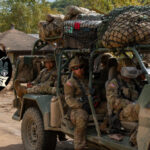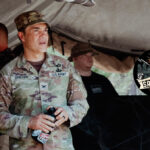
When you’re more focused on lethality you’re less likely to look at ways the military can act to support things that will maybe avoid war in the first place
During his tenure as the Secretary of Defense, James N. Mattis frequently used the term lethality in describing all aspects of the U.S. Department of Defense. It was described as a desired endstate for all acquisitions, it was the subject of criticism in the world of joint Professional Military Education, and service secretaries and chief were given carte blanche to eliminate or restructure anything that hindered or didn’t contribute to lethality.
Andrew Diederich joins Editor-In-Chief Jacqueline Whitt to discuss the shortcomings of that thinking in the strategic realm. If all the DoD concerns itself with is lethality, what roles, what options, what contributions is it at worst ignoring, at best, allowing to deteriorate?
Podcast: Download
LTC Andrew Diederich is a graduate of the U.S. Army War College AY19 Resident Class and currently assigned to Northern Command. Jacqueline E. Whitt is Professor of Strategy at the U.S. Army War College and the Editor-in-Chief of WAR ROOM. The views expressed in this presentation are those of the speakers and do not necessarily reflect those of the U.S. Army War College, U.S. Army, or Department of Defense.
Photo Description: Marine Corps Base Camp Pendleton, Calif. – Cpl. Matthew Teutsch (left) and Cpl. Brett Norman, both combat videographers with the 11th Marine Expeditionary Unit, participate in hand-to-hand and close quarters combat during martial arts training at Camp Pendleton, Calif., Oct. 2, 2018. The Marines worked on offensive and defensive techniques utilizing different weapons systems focusing on the motto of the Martial Arts Program: “One Mind, Any Weapon.”
Photo Credit: U.S. Marine Corps photo by Staff Sgt. Donald Holbert





Excellent podcast. I appreciate both Andrew’s and Jacqueline’s perspectives on this. As a CA Officer, I’ve participated in discussions, both informally and institutionally, on CA’s role in MDO. Its a conundrum to conceptualize and explain how CA is lethal. Jacqueline asked about other words to describe what else the military conducts other than lethality and I contend it is legitimacy. The US military, while it needs lethality for efficacy, is not conducting indiscriminate warfare. CA, along with a number of information capabilities, provides Commander’s with the capability to maintain legitimacy with foreign as well as domestic populations.
Global Health Strategies for Security. That is one line of operations that isn’t utilized as much as it could. So many benefits to putting efforts into GHSS. No super cool action pics and it doesn’t feed into the ‘all things lethal’ optic. When all you have is a hammer everything is a nail.
Terrific discussion. Even after three years at USAWC, I found the most value in your having provided the definition of “lethality” in the first place. I’ve searched for a doctrinal definition in vain; it is not as self-explanatory as it seems inside the DOD culture. My military colleagues struggle to even comprehend the question when I ask what it means… and I’ve gotten responses vaguely ranging from increased mobility to better kit.
Also, as you noted, lethality does not translate well in a strategic, whole-of-government context. It is actually off-putting to partner organizations and has profoundly negative connotations to many non-DOD audiences. Not to mention that killing our way out of strategic problems has been ineffective… it seems in fact to make things worse. Too bad because we’ve learned a lot of hard lessons and risk retreating into our respective agency corners, forgetting that stability ops are not optional, and committing an entire new generation of brave young people (and trillions of dollars) re-learning the limits of “kicking in doors and shooting bad guys.”
For those branches of the military whose role is to kill the enemy, lethality is everything, because when you have resorted to “ultima ratio regum” you want to use force as quickly and/or cleanly as possible to remove obstacles to building stability and peace. The obvious but oft-forgotten corollary to removing obstacles with high explosives is that you need different tools and skill to build anything–you cannot kill your way to peace, only exhaustion. Lethality is the measure of the sharp tools in the box, we simply need to remember that they aren’t the only ones available.
We have less to worry about concerning the priority on Lethality (vice everything else we have to do) than you think. To ease your fears:
1. Consolidating Gains is part of our doctrine. And not just any doctrine, but the manual that “sets the foundation for developing other principles, tactics, techniques, and procedures detailed in subordinate doctrine publications. It articulates the Army’s operational doctrine for unified land operations.” That’s straight from the new ADP 3-0 (31 July 2019). Big section on Consolidating Gains in Chapter 3.
2. The Army’s Operational Concept, ‘Unified Land Operations’, is explicitly NOT just about lethality. “The simultaneous execution of offense, defense, stability, and defense support of civil authorities across multiple domains to shape operational environments, prevent conflict, prevail in large-scale ground combat, and consolidate gains as part of unified action.”
3. We talk about things other than lethality prominently in our professional journals. See an article by the CG of the Combined Arms Center (and others) in August 2019 Military Review, (The Professional Journal of the US Army) https://www.armyupress.army.mil/Journals/Military-Review/Online-Exclusive/2019-OLE/July/Lundy-Three-Perspectives/
4. All that being said, remember, we are the Department of Defense, so when it comes to lethality, we are primarily on salary for that.
We could be well served to ensure that through this lesson on minimizing the importance of lethality we don’t lose sight of why we have a US Army and ground forces in general.
Primarily:
We are not a police force
We are not a force designed to “nation build”
War isn’t won by staying on defense
Offenses that deal higher levels of casualties to an adversary than that received typically result in a win for the attacker
Superior and more lethal forces are desirable to the contrary
There are target/outcome effects at levels other than strategic. Marginalizing the importance of lethality is equally as foolish as overemphasizing it. Inappropriate or overly restrictive ROE poses much more of a threat to today’s force than the recent emphasis on lethality.
James B put it well noting that there are other tools in the statesman’s box. Lethality is surely not the only one. When the situation requires a utilization of high levels of violence, lethality could very well be the edge between winning and losing regardless of how much some wish to marginalize it.